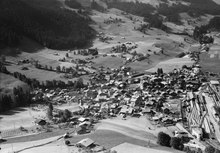Zweisimmen
Zweisimmen is a municipality in the Obersimmental-Saanen administrative district in the canton of Bern in Switzerland.
[3] The oldest trace of a settlement in the area are some scattered mesolithic artifacts from Mannenberg-Riedli.
[3] During the Middle Ages a significant trade route over the Alps to Valais and Lake Geneva passed through the Zweisimmen region.
The villages and castles passed through several noble families until 1378 when the Lord of Düdingen sold the lands to Fribourg following an uprising.
After the Battle of Sempach in 1386, Bern conquered the Simmen river valley (Simmental) and acquired Zweisimmen.
The Bernese administrator over the upper Simmen valley was installed at Blankenburg Castle.
Reichenstein-Terenstein Castle and estates were acquired by the Bubenberg family in 1456, and sold to Bern in 1493.
Blankenburg village remained the political center of the Obersimmental district through the 1798 French invasion and the Act of Mediation in 1803.
Zweisimmen, along with much of the Bernese Oberland initially resisted the new faith, but were forced to convert in the same year.
[3] During the Middle Ages Zweisimmen grew into a local center for trade and government.
In 1644 the annual fair was moved to Zweisimmen and brought cattle and cheese buyers from Italy and Germany to the municipality.
The municipal tourism industry was devastated by the Great Depression and World War II.
Zweisimmen cooperated with the neighboring tourist municipalities of Gstaad, Lenk im Simmental and Adelboden to build extensive ski resorts along with an airfield.
[6] The blazon of the municipal coat of arms is Or a Semi Bear rampant couped Sable langued Gules.
[9] Most of the population (as of 2000[update]) speaks German (2,813 or 94.7%) as their first language, Albanian is the second most common (36 or 1.2%) and Serbo-Croatian is the third (35 or 1.2%).
[14] The historical population is given in the following chart:[3][15][16] The village church and its rectory, the ruins of Oberer Mannenberg Castle and the ruins of Unterer Mannenberg Castle are listed as Swiss heritage site of national significance.
The number of jobs in the primary sector was 168, of which 161 were in agriculture, 6 were in forestry or lumber production and 1 was in fishing or fisheries.
In the tertiary sector; 190 or 23.3% were in wholesale or retail sales or the repair of motor vehicles, 136 or 16.7% were in the movement and storage of goods, 89 or 10.9% were in a hotel or restaurant, 37 or 4.5% were the insurance or financial industry, 43 or 5.3% were technical professionals or scientists, 23 or 2.8% were in education and 219 or 26.9% were in health care.
[24] Zweisimmen is the location of a railway gauge changer kit, made by Stadler Rail.
From the 2000 census[update], 2,354 or 79.3% belonged to the Swiss Reformed Church, while 263 or 8.9% were Roman Catholic.
The wettest month was July during which time Zweisimmen received an average of 153 mm (6.0 in) of rain or snow.
The month with the most days of precipitation was June, with an average of 14.3, but with only 140 mm (5.5 in) of rain or snow.
The driest month of the year was April with an average of 88 mm (3.5 in) of precipitation over 11.3 days.
This is followed by three years of obligatory lower Secondary school where the students are separated according to ability and aptitude.
Following the lower Secondary students may attend additional schooling or they may enter an apprenticeship.





